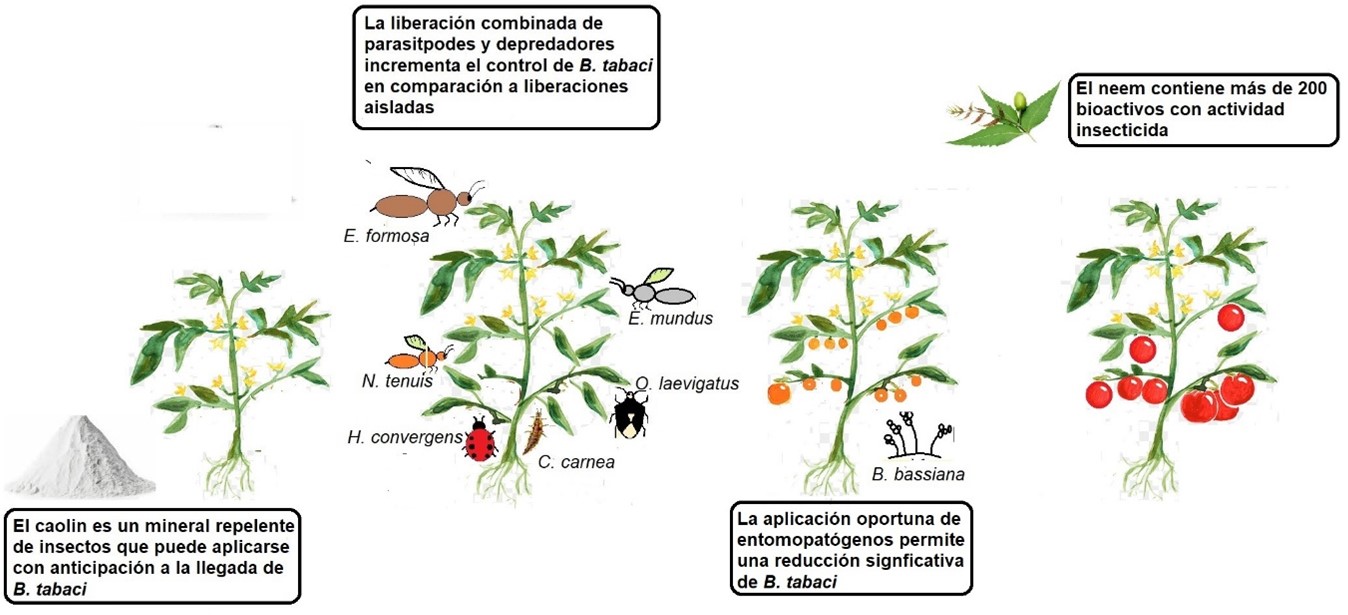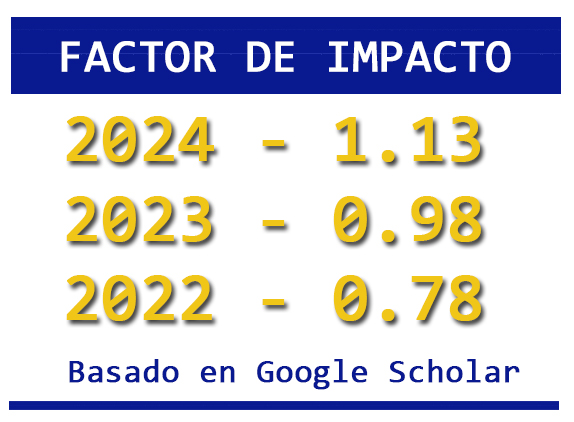Trends in control alternatives for Bemisia tabaci under agricultural crops intensive crops
DOI:
https://doi.org/10.36790/epistemus.v18i37.365Keywords:
white fly, integrated pest management, agricultural cropsAbstract
Bemisia tabaci (Gennadius) is a polyphagous insect that has invaded crop fields around the world. The most effective control in intensive production systems has been based on the use of chemical insecticides; however, their effects are adverse. In light of this, currently, highly efficient control alternatives are emerging that can be used to manage this pest in greenhouses. Nevertheless, the introduction of a new control strategy in an intensive production system represents a challenge that needs evaluation before its implementation. This work presents a review of the current state of the most effective control strategies against this pest in agricultural intensive production.
Downloads
References
Y. Li, G. N. Mbata, S. Punnuri, A. M. Simmons y D. I. Shapiro-Ilan, “Bemisia tabaci on Vegetables in the Southern United States: Incidence, Impact, and Management”, Insects, vol. 12, p. 198, 2021. http://doi.org/10.3390/insects12030198 DOI: https://doi.org/10.3390/insects12030198
R. M. Hassan, H. M. Abouyousef, K. H. E. Haggag y B. Y. Riad, “Evaluation of enzymes role in insecticides resistance mechanism of Bemisia tabaci (GENNADIUS) from seven governorates of Egypt,” Plant Archives, vol. 20, pp. 565-573, 2020.
T. R. Grasswitz, “Integrated Pest Management (IPM) for Small-Scale Farms in Developed Economies: Challenges and Opportunities,” Insects, vol. 10, p. 179, 2019. http://doi.org/10.3390/INSECTS10060179 DOI: https://doi.org/10.3390/insects10060179
L. J. Cao, Y. F. Gao, Y. J. Gong, J. C. Chen, M. Chen, A. Hoffmann y S. J. Wei, “Population analysis reveals genetic structure of an invasive agricultural thrips pest related to invasion of greenhouses and suitable climatic space,” Evolutionary Applications, vol. 12, pp. 1868-1880, 2019. http://doi.org/10.1111/eva.12847 DOI: https://doi.org/10.1111/eva.12847
A. R. Horowitz, M. Ghanim, E. Roditakis, R. Nauen y I. Ishaaya, “Insecticide resistance and its management in Bemisia tabaci species,” Journal of Pest Science, vol. 93, pp. 893-910. 2020. http://doi.org/10.1007/s10340-020-01210-0 DOI: https://doi.org/10.1007/s10340-020-01210-0
T. C. Sparks, N. Storer, A. Porter, R. Slater y R. Nauen, “Insecticide resistance management and industry: the origins and evolution of the Insecticide Resistance Action Committee (IRAC) and the mode of action classification scheme,” Pest Management Science, vol. 77, pp. 2609-2619, 2021. http://doi.org/10.1002/PS.6254 DOI: https://doi.org/10.1002/ps.6254
A. G. Latora, C. B. Codod, S. Legarrea, B. Dutta, R. C. Kemerait, S. Adkins, W. Turechek, T. Coolong, da A. L. B. R. Silva y R. Srinivasan, “Combining Cultural Tactics and Insecticides for the Management of the Sweetpotato Whitefly, Bemisia tabaci MEAM1, and Viruses in Yellow Squash,” Horticulturae, vol. 8, p. 341, 2022. http://doi.org/10.3390/HORTICULTURAE8040341 DOI: https://doi.org/10.3390/horticulturae8040341
J. U. Niemann, M. Menssen y H. M. Poehling, “Manipulation of landing behaviour of two whitefly species by reflective foils,” Journal of Plant Diseases and Protection, vol. 128, 97-108, 2021. https://doi.org/10.1007/s41348-020-00394-y DOI: https://doi.org/10.1007/s41348-020-00394-y
J. Chen, Y. Fan, T. Wang, C. Zhang, Z. Qiu y Y. He, “Automatic Segmentation and Counting of Aphid Nymphs on Leaves Using Convolutional Neural Networks,” Agronomy, vol. 8, p. 129, 2018. http://doi.org/10.3390/agronomy8080129 DOI: https://doi.org/10.3390/agronomy8080129
R. Yanagisawa, R. Suwa, T. Takanashi y H. Tatsuta, “Substrate-borne vibrations reduced the density of tobacco whitefly Bemisia tabaci (Hemiptera: Aleyrodidae) infestations on tomato, Solanum lycopersicum: an experimental assessment,” Applied Entomology and Zoology, vol. 56, pp. 157-163, 2021. http://doi.org/10.1007/s13355-020-00711-9 DOI: https://doi.org/10.1007/s13355-020-00711-9
T. C. Leskey, B. D. Short, M. Emery, B. Evans, W. Janisiewicz y F. Takeda, “Effect of UV-C Irradiation on Greenhouse Whitefly, Trialeurodes vaporariorum (Hemiptera: Aleyrodidae),” Florida Entomologist, vol. 104, pp. 148-150, 2021. http://doi.org/10.1653/024.104.0215 DOI: https://doi.org/10.1653/024.104.0215
J. U. Niemann y H. M. Poehling, “Effect of narrow-banded blue LED device on host plant settlement by greenhouse whitefly and currant-lettuce aphid,” Journal of Plant Diseases and Protection, pp. 1-9, 2022. http://doi.org/10.1007/S41348-022-00622-7 DOI: https://doi.org/10.1007/s41348-022-00622-7
N. Johnston, T. Paris, M. L. Paret, J. Freeman y X. Martini, “Repelling whitefly (Bemisia tabaci) using limonene-scented kaolin: A novel pest management strategy,” Crop Protection, vol. 154, p. 105905, 2022. http://doi.org/10.1016/j.cropro.2022.105905 DOI: https://doi.org/10.1016/j.cropro.2022.105905
E. S. Melo, F. A. de Assis, F. J. Carvalho, G. A. de Assis y F. A. Rodrigues, “Does diatomaceous earth improve agronomic characteristics and induce resistance to arthropod pest in physalis?,” Revista de Ciências Agroveterinárias, vol. 21, pp. 504-515, 2022. http://doi.org/10.5965/223811712142022504 DOI: https://doi.org/10.5965/223811712142022504
V. Zeni, G. V. Baliota, G. Benelli, A. Canale y C. G. Athanassiou, “Diatomaceous Earth for Arthropod Pest Control: Back to the Future,” Molecules, vol. 26, p. 7487, 2021. http://doi.org/10.3390/MOLECULES26247487 DOI: https://doi.org/10.3390/molecules26247487
H. A. Smith, “Biopesticides for Management of Bemisia tabaci MEAM1 (Hemiptera: Aleyrodidae) and Tomato Yellow Leaf Curl Virus,” Journal of Economic Entomology, vol. 113, pp. 2310-2318, 2020. https://doi.org/10.1093/jee/toaa131 DOI: https://doi.org/10.1093/jee/toaa131
R. Buitenhuis, M. Brownbridge, A. Brommit, T. Saito y G. Murphy, “How to Start with a Clean Crop: Biopesticide Dips Reduce Populations of Bemisia tabaci (Hemiptera: Aleyrodidae) on Greenhouse Poinsettia Propagative Cuttings,” Insects, vol. 7, p. 48, 2016. http://doi.org/10.3390/INSECTS7040048 DOI: https://doi.org/10.3390/insects7040048
T. Curkovic, “Detergents and soaps as tools for IPM in agriculture. Integrated pest management (IPM),” Environ Sound Pest Manag, vol. 5, pp. 12-23, 2016. https://doi.org/10.5772/64343 DOI: https://doi.org/10.5772/64343
P. Juma, N. Njau, C. M. Micheni, H. A. Khan, O. W. Mitalo y D. Odongo, “Trends in Neem (Azadirachta indica)-Based Botanical Pesticides” New and Future Development in Biopesticide Research: Biotechnological Exploration, pp. 137-156, 2022. http://doi.org/10.1007/978-981-16-3989-0_5 DOI: https://doi.org/10.1007/978-981-16-3989-0_5
M. D. Gogi, A. H. Syed, B. Atta, M. Sufyan, M. J. Arif, M. Arshad, A. Nawaz, M. A. Khan, A. Mukhtar y O. E. Liburd, “Efficacy of biorational insecticides against Bemisia tabaci (Genn.) and their selectivity for its parasitoid Encarsia formosa Gahan on Bt cotton,” Scientific Reports, vol. 11, 1-12, 2021. http://doi.org/10.1038/s41598-021-81585-x DOI: https://doi.org/10.1038/s41598-021-81585-x
A. Kheirodin, A. M. Simmons, J. C. Legaspi, E. E. Grabarczyk, M. D. Toews, P. M. Roberts y J. M. Schmidt, “Can generalist predators control Bemisia tabaci?,” Insects, vol. 11, pp. 823, 2020. https://doi.org/10.3390/insects11110823 DOI: https://doi.org/10.3390/insects11110823
S. Pehlivan, T. Alinç, T. D. Achiri y E. Atakan, “Functional responses of two predatory bugs (Hemiptera: Anthocoridae) to changes in the abundance of Tetranychus urticae (Acari: Tetranychidae) and Bemisia tabaci (Hemiptera: Aleyrodidae),” EUROPEAN JOURNAL OF ENTOMOLOGY, vol. 117, 49-55, 2020. http://doi.org/10.14411/EJE.2020.005 DOI: https://doi.org/10.14411/eje.2020.005
D. B. Silva, A. Hanel, F. P. Franco, M. de Castro Silva‐Filho y J. M. S. Bento, “Two in one: the neotropical mirid predator Macrolophus basicornis increases pest control by feeding on plants,” Pest Management Science, vol. 78, vol. 3314-3323, 2022. https://doi.org/10.1002/ps.6958 DOI: https://doi.org/10.1002/ps.6958
I. J. Nair, S. Sharma y R. Kaur, “Efficacy of the green lace wing, Chrysoperla zastrowi sillemi (Esben-Peterson) (Neuroptera: Chrysopidae), against sucking pests of tomato: an appraisal under protected conditions,” Egyptian Journal of Biological Pest Control, 30, 1-6, 2020. http://doi.org/10.1186/S41938-020-00277-2 DOI: https://doi.org/10.1186/s41938-020-00277-2
M. F. A. Jallow, A. A. Dahab, M. S. Albaho y V. Y. Devi, “Efficacy of Nesidiocoris tenuis (Hemiptera: Miridae) and Bacillus thuringiensis (Berliner) for controlling Tuta absoluta (Lepidoptera: Gelechiidae) in greenhouse tomato crops under Kuwait hot desert climate,” International Journal of Pest Management, pp. 1-11, 2022. https://doi.org/10.1080/09670874.2022.2162998 DOI: https://doi.org/10.1080/09670874.2022.2162998
P. Souto, G. Abraços-Duarte y E. Figueiredo, “Fruit Damage by Dicyphus cerastii and Nesidiocoris tenuis (Hemiptera: Miridae) on Tomato,” Proceedings of the 1st of International Electronic Conference on entomology, p. 10363, 2021. http://doi.org/10.3390/iece-10363 DOI: https://doi.org/10.3390/IECE-10363
H. A. Smith y K. L. Krey, “Three Release Rates of Dicyphus hesperus (Hemiptera: Miridae) for Management of Bemisia tabaci (Hemiptera: Aleyrodidae) on Greenhouse Tomato,” Insects, 10, 213, 2019. http://doi.org/10.3390/INSECTS10070213 DOI: https://doi.org/10.3390/insects10070213
G. I. González-Dufau, J. Santamaría-Guerra, K. Castrejon, I. Herrera y A. Monzón, “Interacciones tróficas entre Eretmocerus eremicus (HYMENOPTERA: APHELINIDAE) Y Trialeurodoes vaporariorum (HEMIPTERA: ALEYRODIDAE) en tomate y pimentón,” Ciencia Agropecuaria, 31, 1-18, 2020.
H. Y. Xu, N. W. Yang, H. Chi, G. D. Ren y F. H. “Wan Comparison of demographic fitness and biocontrol effectiveness of two parasitoids, Encarsia sophia and Eretmocerus hayati (Hymenoptera: Aphelinidae), against Bemisia tabaci (Hemiptera: Aleyrodidae),” Pest Management Science, vol. 74, pp. 2116-2124, 2018. http://doi.org/10.1002/ps.4908 DOI: https://doi.org/10.1002/ps.4908
A. Litwin, M. Nowak y S. Różalska, “Entomopathogenic fungi: unconventional applications,” Reviews in Environmental Science and Bio/Technology, vol. 19, pp. 23-42, 2020. http://doi.org/10.1007/S11157-020-09525-1 DOI: https://doi.org/10.1007/s11157-020-09525-1
H. Singh y N. Joshi, “Management of the aphid, Myzus persicae (Sulzer) and the whitefly, Bemisia tabaci (Gennadius), using biorational on capsicum under protected cultivation in India,” Egyptian Journal of Biological Pest Control, vol. 30, pp. 1-9, 2020. http://doi.org/10.1186/S41938-020-00266-5/FIGURES/2 DOI: https://doi.org/10.1186/s41938-020-00266-5
O. Murillo-Ramírez, M. C. Ramírez-Montoya y A. Soto-Giraldo, “Effect of sublethal doses of azadirachtina on the ability to search of the parasitoid Encarsia formosa Gahan,” Boletin Cientifico Del Centro de Museos, vol. 24, pp. 68-75, 2020. http://doi.org/10.17151/bccm.2020.24.1.4 DOI: https://doi.org/10.17151/bccm.2020.24.1.4
S. Grover, V. Jindal y G. Banta, “RNA interference mediated knockdown of juvenile hormone esterase gene in Bemisia tabaci (Gennadius): Effects on adults and their progeny,” Journal of Asia-Pacific Entomology, vol. 22, pp. 56-62, 2019. https://doi.org/10.1016/j.aspen.2018.12.002 DOI: https://doi.org/10.1016/j.aspen.2018.12.002
C. Gong, Z. Yang, Y. Hu, Q. Wu, S. Wang, Z. Guo y Y. Zhang, “Silencing of the BtTPS genes by transgenic plant‐mediated RNAi to control Bemisia tabaci MED,” Pest Management Science, vol. 78, pp. 1128-1137, 2022. https://doi.org/10.1002/ps.6727 DOI: https://doi.org/10.1002/ps.6727
D. Lu, H. Yue, L. Huang, D. Zhang, Z. Zhang, Z. Zhang y Y. Liu, “Suppression of Bta11975, an α‐glucosidase, by RNA interference reduces transmission of tomato chlorosis virus by Bemisia tabaci,” Pest Management Science, vol. 77, pp. 5294-5303, 2021. https://doi.org/10.1002/ps.6572 DOI: https://doi.org/10.1002/ps.6572
M. Taheri Sarhozaki, S. Aramideh, J. Akbarian y S. Pirsa, “Effects of ZnO nanoparticles and Kaolin in combination with NeemAzal-T/S against Bemisia tabaci and its parasitoid Eretmocerus mundus on cotton,” Chemical Review and Letters, vol. 3, pp. 131-139, 2020. http://doi.org/10.22034/CRL.2020.235381.1066
G. Salerno, M. Rebora, S. Piersanti, V. Saitta, A. Kovalev, E. Gorb y S. Gorb, “Reduction in insect attachment caused by different nanomaterials used as particle films (kaolin, zeolite, calcium carbonate)” Sustainability (Switzerland), vol. 13, p. 8250, 2021. http://doi.org/10.3390/su13158250 DOI: https://doi.org/10.3390/su13158250
M. C. Peres, G. C. de Souza Costa, L. E. L. dos Reis, L. D. da Silva, M. F. Peixoto, C. C. F. Alves, M. R. Forim, E. D. Quintela, W. L. Araújo y C. de Melo Cazal, “In natura and nanoencapsulated essential oils from Xylopia aromatica reduce oviposition of Bemisia tabaci in Phaseolus vulgaris,” Journal of Pest Science, vol. 93, pp. 807-821, 2020. http://doi.org/10.1007/S10340-019-01186-6 DOI: https://doi.org/10.1007/s10340-019-01186-6

Downloads
Published
How to Cite
Issue
Section
License
Copyright (c) 2024 EPISTEMUS

This work is licensed under a Creative Commons Attribution-NonCommercial-ShareAlike 4.0 International License.
The magazine acquires the patrimonial rights of the articles only for diffusion without any purpose of profit, without diminishing the own rights of authorship.
The authors are the legitimate owners of the intellectual property rights of their respective articles, and in such quality, by sending their texts they express their desire to collaborate with the Epistemus Magazine, published biannually by the University of Sonora.
Therefore, freely, voluntarily and free of charge, once accepted the article for publication, they give their rights to the University of Sonora for the University of Sonora to edit, publish, distribute and make available through intranets, Internet or CD said work, without any limitation of form or time, as long as it is non-profit and with the express obligation to respect and mention the credit that corresponds to the authors in any use that is made of it.
It is understood that this authorization is not an assignment or transmission of any of your economic rights in favor of the said institution. The University of Sonora guarantees the right to reproduce the contribution by any means in which you are the author, subject to the credit being granted corresponding to the original publication of the contribution in Epistemus.
Unless otherwise indicated, all the contents of the electronic edition are distributed under a license for use and Creative Commons — Attribution-NonCommercial-ShareAlike 4.0 International — (CC BY-NC-SA 4.0) You can consult here the informative version and the legal text of the license. This circumstance must be expressly stated in this way when necessary.
The names and email addresses entered in this journal will be used exclusively for the purposes established in it and will not be provided to third parties or for their use for other purposes.























